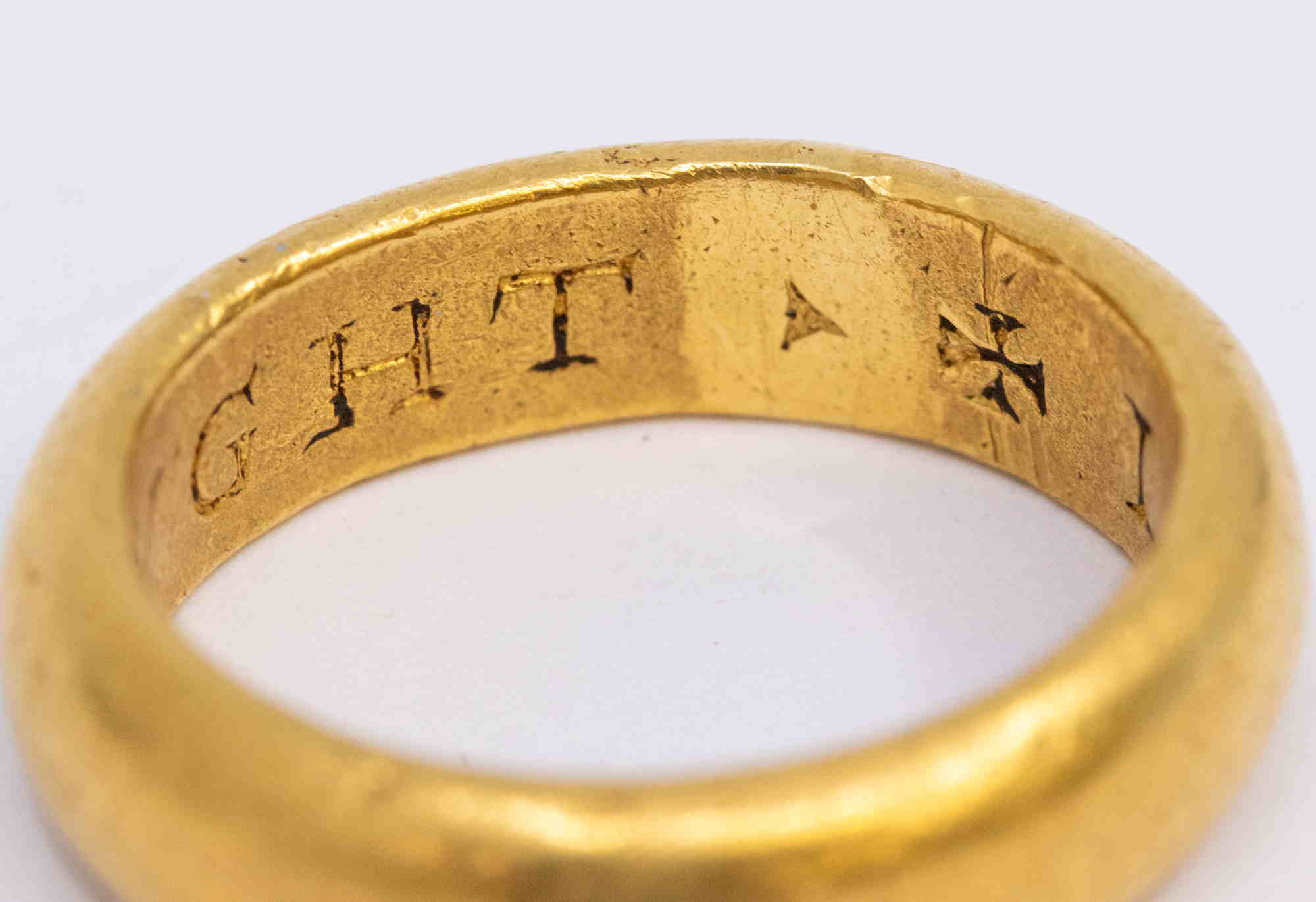‘Sheriff of Nottingham’s’ gold ring in sale
 An ancient gold ring found by a metal detectorist could be part of a hoard of treasure hidden by the Sheriff of Nottingham centuries ago.
An ancient gold ring found by a metal detectorist could be part of a hoard of treasure hidden by the Sheriff of Nottingham centuries ago.
The circa 1560 posy ring, a popular 16th-century love token, bears a mystery message: I Meane Ryght. Due to the circumstances surrounding its discovery, the finder thinks it may have belonged to a Sheriff of Nottingham or a member of his family.

The ring, which weighs almost 15g and is around 460 years old, was unearthed during a metal detecting club event. Lincoln’s Andy Taylor, 57, dug up the posy ring and, five minutes later, Graham Harrison, a 65-year-old retired merchant navy engineer officer, found a signet ring believed to belong to a former Sheriff of Nottingham.
Graham’s find, which sold for £8,500 at Hansons Auctioneers in March 2022, bore the crest of the Jenison family. They served as High Sheriffs of Nottingham hundreds of years ago. Legend has it that the Jenisons gleaned great wealth from valuables left in their safekeeping during the Civil War which were never reclaimed. This theory was seemingly corroborated when a buried hoard of Civil War silver coins was unearthed from the same field where both rings were found.
Andy believes his posy ring may have belonged to a Sheriff of Nottingham too, or someone known to him. It’s set to go under the hammer at Hansons Auctioneers in October with a guide piece of £2,000-£3,000.
Andy, who’s been metal detecting for eight years and works for a water company, said: “I found it on a sunny July day in 2020. I was on a dig with around a dozen people from a metal detecting club. We were on farmer’s land at Radcliffe-on-Trent in Rushcliffe, Nottinghamshire.
“It was so hot, I decided to go back to my car to fetch my drink. I was lucky. Just as I turned back, I picked up a lovely strong signal. I dug a divot in the sandy soil and there was the ring, just looking at me.

“It was an exciting find. When that signal goes off you never know whether it will be a ring-pull or ancient treasure. Within five minutes of me finding it, Graham dug up the Sheriff of Nottingham ring nearby. Some coins were discovered in the area on the same day too.
“I’m 95% certain both the rings and coins originally belonged to the same person. They were all found within 10 square metres of each other. The land had been disturbed by a pipe being laid at some point, otherwise they might have been closer together.
“In my opinion it was a stash of valuables buried at the same time. Legend has it that the Sheriff of Nottingham’s family hid valuables. I think the ring may have belonged to him or someone close to him. It appears to be a man’s posy ring, which is unusual. It’s the second largest ring of its type ever seen according to a report I received from the British Museum.
“I have never sold any of my metal detecting discoveries before but if I don’t part with the ring it will just be stuck in a pot forever with my best finds. I would like it to go to someone who will appreciate its historical value.”
Charles Hanson, owner of Hansons Auctioneers, said: “This posy ring is awash with intrigue thanks to its mystery message and possible connection to the Sheriff of Nottingham or the Jenison family. Perhaps it was a gift to mark high status.
“The sheriff’s signet ring bore the crest of the Jenison family. The Nottinghamshire branch of the Jenison family first appeared as aldermen of Newark in 1580. Each generation served as aldermen and, after the 1626 charter, as mayors.
“I suspect the posy ring was lost, or buried for safekeeping, in the mid-16th century, perhaps in the reign of the short-lived Edward IV or in the very early years of Queen Elizabeth I’s reign (1558 to 1603). The font reflects the Roman capitals used until around 1560. After that time italics started to make an appearance.
“Posy rings were often used as betrothal or wedding rings centuries ago. The messages inscribed inside were a secret to all but the wearer and giver, so we can never be certain what ‘I Meane Ryght’ meant to the owner of the ring.

“Its weight indicates its owner was wealthy. It was likely given as a token of love or esteem nearly 500 years ago. We’re thrilled to be offering it with a guide of £2,000 to £3,000 but suspect it could fetch as much as £5,000. It would, perhaps, suit a newly-engaged couple keen to ‘Meane Ryght’ by each other.
“It’s remarkable to think this ring was probably given to its original wearer 120 years before the Great Fire of London in 1666 and was crafted out of gold before the Spanish Armada set sail in 1588. For any lover of history it has to be the ultimate gift.
“Of course, mention of the Sheriff of Nottingham reminds us of Robin Hood but the signet ring sold in 2022 related to a later sheriff. Tales of Robin Hood emerged in English folklore as early as the 13th and 14th centuries. Nevertheless, these finds still evoke those memories and remind us of Nottinghamshire life during the turbulent times of the 16th and 17th centuries.”
The posy ring, which has been processed through the Portable Antiquities Scheme, will be offered in Hansons Auctioneers’ October 5-6 Fine Art Auction.

